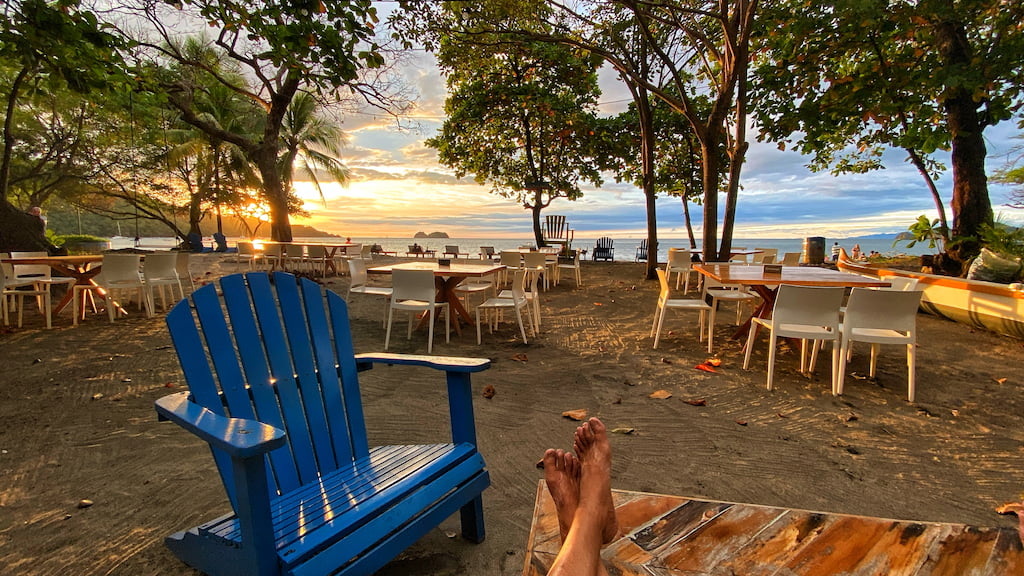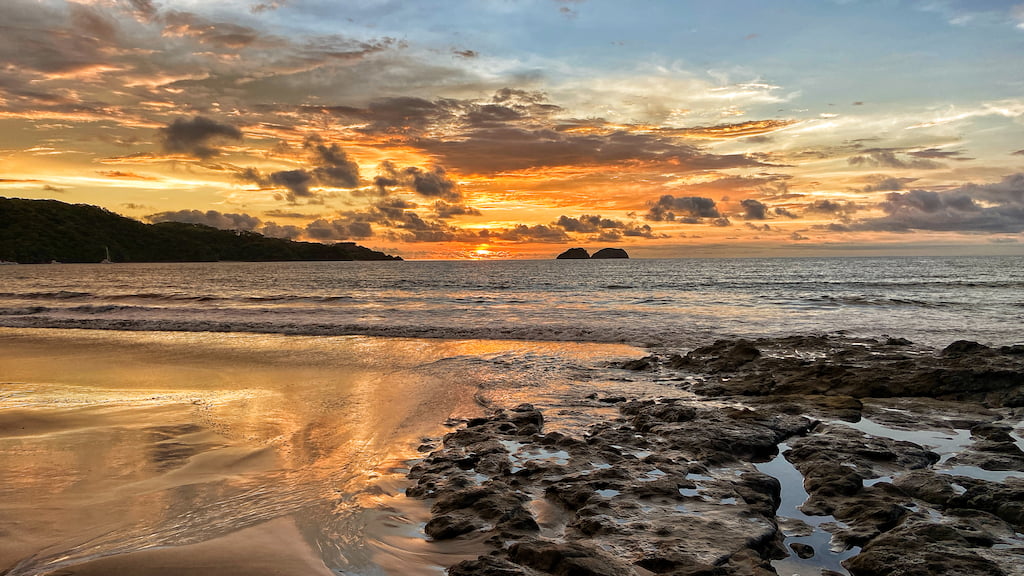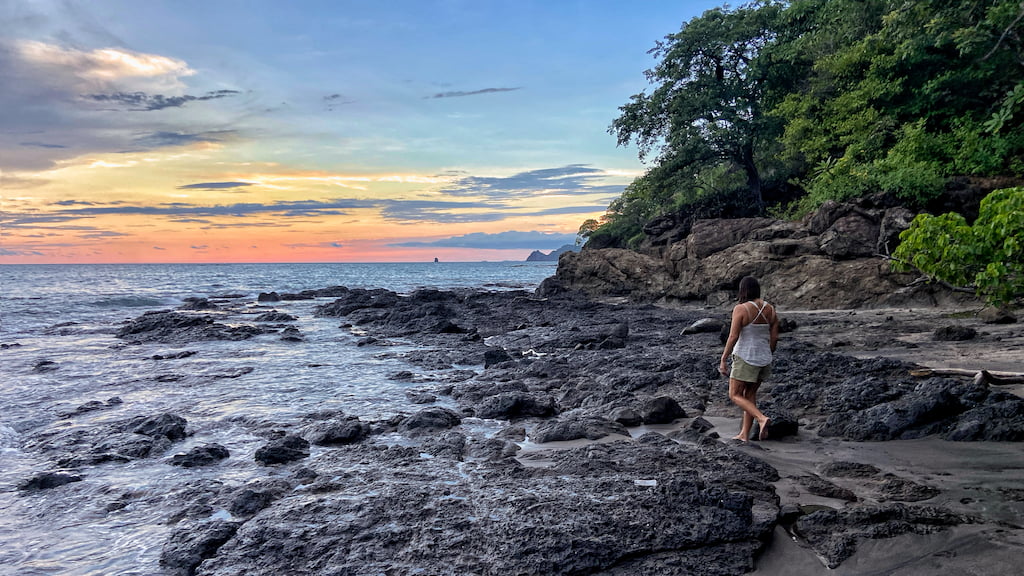October in Papagayo crowns the six-month green season — our winter, or "invierno."
Unlearn what you know up north: in Guanacaste limes turn yellow, oranges stay green, and winter in Guanacaste only gets greener!
October is Papagayo’s wettest month: afternoons of steady, replenishing rain punctuate long windows of calm sea and quiet beaches, turning the landscape a deep, vivid green. As a rule of thumb, winter here in northwest Guanacaste - a.k.a. green season or low season – generally runs from May 15th to November 15th with September and October being the months yielding the most precipitation. The graph below for nearby Sardinal sums it up.
(Click here or on image on the left for more information on Climate and Average Weather Year-Round in Sardinal, Costa Rica)
October in Papagayo arrives like a private season. The hotels and resorts here remain mostly open, but their acceleration eases. Check-in lines shorten, maintenance and renovations are performed, the umbrellas normally found on the sand are folded or stowed until summer, and the soundtrack of loud, daylong activity is replaced by a softer playlist of waves, rain, monkeys, roosters, and parrots. The sense is less of businesses closing than of people reclaiming time: repairs get done, family meals are longer, and the rhythms of community slip away from sheer commerce.
 The beaches are mostly left to us locals, fishermen, and a few determined skim boarders. Morning light finds lanchas, “veleros” (sail boats), catamarans, and an assortment of fishing boats anchored just offshore with kayaks for getting to and from them stacked and chained to the coconut palms and dry forest trees growing at the high tide line. The beachfront restaurants are uncrowded and sometimes even deserted in the mornings, trading cocktail service for pitchers of coffee along with Tico and Gringo style breakfasts. “Sunset snipers” are rewarded with dramatic skies — transient clouds that craft long shadows and plethora saturated colors.
The beaches are mostly left to us locals, fishermen, and a few determined skim boarders. Morning light finds lanchas, “veleros” (sail boats), catamarans, and an assortment of fishing boats anchored just offshore with kayaks for getting to and from them stacked and chained to the coconut palms and dry forest trees growing at the high tide line. The beachfront restaurants are uncrowded and sometimes even deserted in the mornings, trading cocktail service for pitchers of coffee along with Tico and Gringo style breakfasts. “Sunset snipers” are rewarded with dramatic skies — transient clouds that craft long shadows and plethora saturated colors.
 Rain comes more in gentle episodes rather than all-day deluges. The rain arrives in softer, episodic patterns here than in Guanacaste’s interior — short, cleansing bursts or long, gentle curtains that pass and leave salt-and-sand ready for the next wave of sun. Enough to slick the black volcanic sand and make the dry tropical forest foliage shine, but often leaving long windows of warm, calm surf and radiant sunshine between showers.
Rain comes more in gentle episodes rather than all-day deluges. The rain arrives in softer, episodic patterns here than in Guanacaste’s interior — short, cleansing bursts or long, gentle curtains that pass and leave salt-and-sand ready for the next wave of sun. Enough to slick the black volcanic sand and make the dry tropical forest foliage shine, but often leaving long windows of warm, calm surf and radiant sunshine between showers.
With fewer sunbathers, tide pools and rocky coves reclaim a hush: ghost crabs patrol exposed rock, whimbrels and sand pipers run determinedly up and down where ocean meets sand, tiger herons hunt the shallows of mangler in the tidal estuaries, howler monkeys howl overhead, and garrobos and iguanas snooze in the wet, leaf laden tree branches nearly touching the ground under their own weight.
 Tourism shifts from crowded days to intimate experiences. Private-charter oats still run trips for small groups; boutique hotels host guests who come for the quiet and who aren’t much for nightlife. There are plenty of chairs and cabañas at beach clubs and hotels; yoga classes keep small, devoted circles. Early morning walks and late afternoon beachcombing feel like solitary rituals. My 5k morning beach run is my church. Amen.
Tourism shifts from crowded days to intimate experiences. Private-charter oats still run trips for small groups; boutique hotels host guests who come for the quiet and who aren’t much for nightlife. There are plenty of chairs and cabañas at beach clubs and hotels; yoga classes keep small, devoted circles. Early morning walks and late afternoon beachcombing feel like solitary rituals. My 5k morning beach run is my church. Amen.
There is also an economy of kindness that comes with fewer people. Staff at local businesses trade brisk high-season service for slower, more personalized attention — they know most guests by name and time stretches for longer conversations about what fish are running right now, the best places for beach setups or to take in a sunset, whether or not the Monkey Trail river crossing is passable, and what they’re going to be for Halloween.
For visitors who choose October, the season rewards curiosity and slowness. Roads that swelled with rental cars feel friendlier. Paths are slow and leisurely – but slippery. Street parking everywhere, and especially in El Coco, is a breeze. But off the pavement ventures, though muddy and alive, should not be taken lightly and require a decent 4WD vehicle and plenty of gas just in case.
 Evening activities center on simpler pleasures — a moonlit walk, a shared plate of ceviche, or taking in a sunset on a private stretch of sand. Nighttime is softer: fewer lights along the shore, more stars filtered through the clouds, and the distant, reassuring pulse of waves. The low season here isn’t empty so much as selective — it is for people who come to listen: to the surf, the rain, and to the gentle return of a landscape that has finally had its fill. In another couple of weeks, the rains will subside, and it will be the sun’s turn to again rule the day for the next six months.
Evening activities center on simpler pleasures — a moonlit walk, a shared plate of ceviche, or taking in a sunset on a private stretch of sand. Nighttime is softer: fewer lights along the shore, more stars filtered through the clouds, and the distant, reassuring pulse of waves. The low season here isn’t empty so much as selective — it is for people who come to listen: to the surf, the rain, and to the gentle return of a landscape that has finally had its fill. In another couple of weeks, the rains will subside, and it will be the sun’s turn to again rule the day for the next six months.
 October in Papagayo is not a territory reclaimed so much as a quieter conversation between land and sea. The shoreline tightens its boundaries — tides becoming more visible, the dry forest tree line stands like a towering emerald wall of giant broccoli, the ocean is warm, and currents become calmer between rains. Within this space, Papagayo’s daily life rearranges itself to suit fewer visitors and more residents, and the result is a version of Guanacaste that feels worn-in, honest, and immensely generous.
October in Papagayo is not a territory reclaimed so much as a quieter conversation between land and sea. The shoreline tightens its boundaries — tides becoming more visible, the dry forest tree line stands like a towering emerald wall of giant broccoli, the ocean is warm, and currents become calmer between rains. Within this space, Papagayo’s daily life rearranges itself to suit fewer visitors and more residents, and the result is a version of Guanacaste that feels worn-in, honest, and immensely generous.
If you come for a week, you leave having learned a coastline’s secrets; if you come to stay, you settle into a rhythm where rain and tide mark the hours and the horizon grows wider with each patient, green day.
Does this sound like something you’d enjoy? Just reach out I’ll be there!








